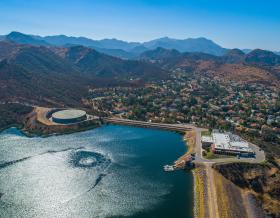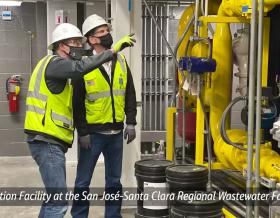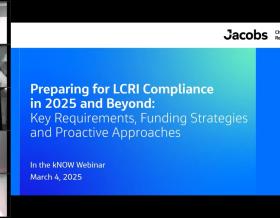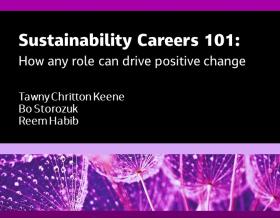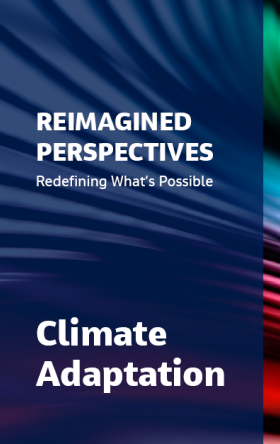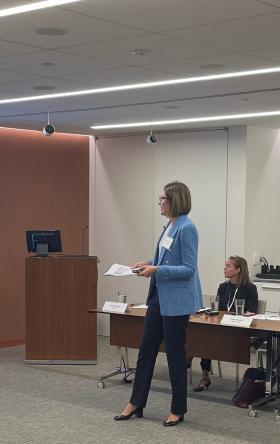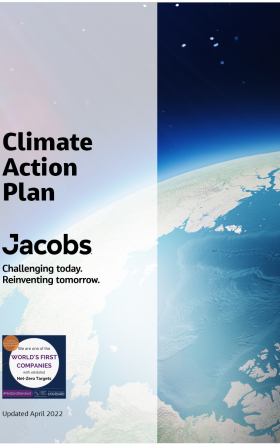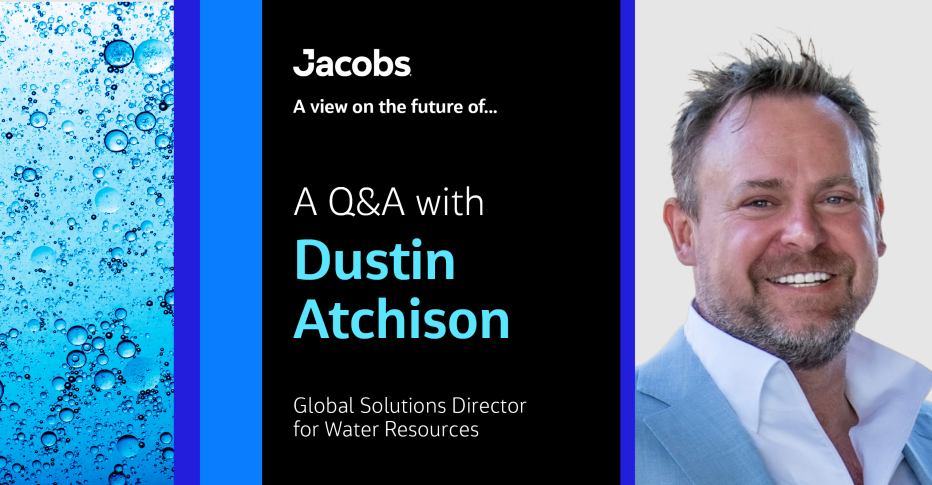
Water is a shared natural resource that shapes our lives, communities, ecosystems and climate. But managing it has never been more complex.
As our world faces challenges like increased water shortages, growing demand, water pollution and vulnerability to natural hazards, Jacobs works with our clients and their communities to better manage water resources and improve resilience to climate change.
In this Q&A, we connect with Jacobs Global Solutions Director for Water Resources, Dustin Atchison. Dustin leads our global Water Resources team, which is committed to advancing integrated water stewardship by addressing environmental pressures and resource demands, delivering resilient, cross-sector solutions that protect assets, support healthy water bodies and help communities thrive now and into the future.
Tell us a bit about your work as Jacobs Global Solutions Director for Water Resources, and what we offer our clients in this space.
As Global Solutions Director for Water Resources, I lead our efforts to solve complex water challenges around the world. Our team provides a wide range of services - from flood risk management and coastal resilience to water scarcity solutions and integrated catchment management.
We're constantly pushing the boundaries, leveraging cutting-edge technology and cross-sector expertise to deliver long-term, community-focused water resources solutions for our clients. It's a dynamic role that allows me to work with talented people across the globe on some of the most pressing water issues of our time.
What are the biggest water resources challenges today?
We’re facing a perfect storm. Changing weather patterns are driving more frequent and intense events, such as flooding, droughts and rising sea levels. Urbanization is placing immense pressure on existing water infrastructure. And water scarcity continues to grow, requiring a delicate balancing act between the needs of nature, people and industry.
In the Americas, we're seeing a shift in funding landscapes, pushing state and local entities to get creative with partnerships and investment strategies. There's also an increased focus on ensuring that water resource management benefits all communities, including those historically underserved. It's a complex landscape but one that presents exciting opportunities for innovation.
How are we helping our clients to think differently as they respond to future challenges?
We take a multi-faceted approach. Digital transformation is central – we're applying technologies like our Flood Platform and integrating artificial intelligence (AI) and machine learning to support faster, smarter decisions. But it's not just about technology. We recognize that water challenges don't exist in isolation, so we bring together expertise across multiple sectors to deliver integrated, cross-market solutions.
Most important, we put people first. Our designs go beyond essential services – they enhance community value. Think of stormwater parks that double as recreational spaces or projects that incorporate workforce development initiatives. It's about creating solutions that resonate with and benefit the communities we serve.
What are the biggest opportunities ahead in water resources?
The challenges facing our clients today present significant opportunities to rethink how we plan, fund and manage water systems. As water infrastructure grows more complex and pressures and demands increase, communities can adopt integrated strategies that recognize the vital connections between water, land, food, energy and community health. This enables more resilient systems that combine traditional infrastructure with nature-based solutions and digital enhancements, such as smart flood systems that use data and AI to respond to changing conditions.
As costs rise and expectations evolve, there’s also a shift towards community-centered approaches that deliver multiple benefits. For example, stormwater parks improve water quality, provide flood protection and create valuable public spaces. We’re also seeing a wider range of funding tools and mechanisms, including collaborative delivery models and blended public-private financing, such as community-based public-private partnerships and environmental impact bonds. These approaches help clients implement solutions that support responsible investment, net zero water stewardship and other community goals.
Is there a project you’re particularly proud of?
The Greater Manchester Integrated Catchment Management Plan is one that I would certainly highlight due to its integrated approach that solves water challenges at scale. Another that stands out is the City of New Orleans Lakeview Hydraulics and Hydrology study. New Orleans has a long, complicated relationship with water, and this project aimed to reduce chronic flooding in a meaningful way. Our approach integrated blue, green and grey infrastructure to create a holistic solution. It was a great example of how we tap into our global network while also working closely with local stakeholders. The result was a plan that not only addresses the city’s technical needs but prioritizes community benefits. It's a great example of how Jacobs blends global knowledge with local insight to deliver tailored, effective solutions.
About the interviewee

Dustin Atchison is Jacobs’ Global Solutions Director for Water Resources. With more than 27 years of experience in water resources and stormwater management, Dustin leads a global team committed to protecting communities and the environment while managing the world’s precious water resources. Dustin is a recognized industry leader in green infrastructure and nature-based solutions. His expertise spans the master planning, design and implementation of stormwater systems that deliver multiple community benefits. He has also led projects focused on stream and wetland restoration, as well as culvert fish passage improvements.
A project manager and certified engineer, Dustin completed his master’s degree in civil and environmental engineering at the University of Wisconsin-Madison and a bachelor’s degree from the University of Washington.



